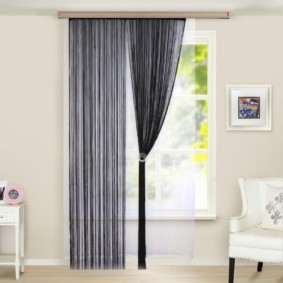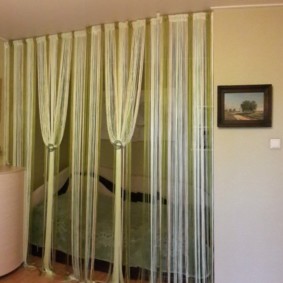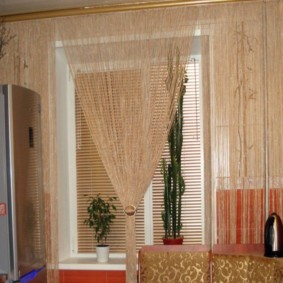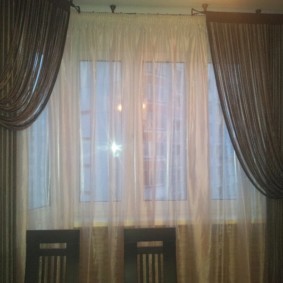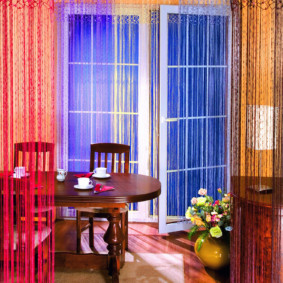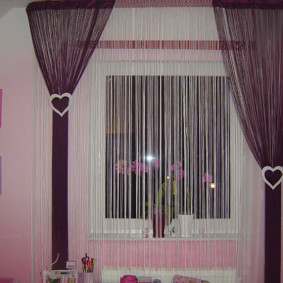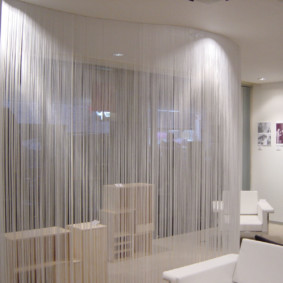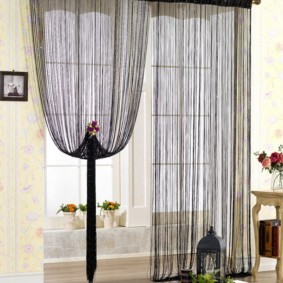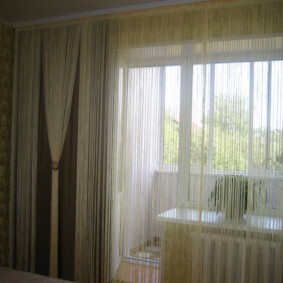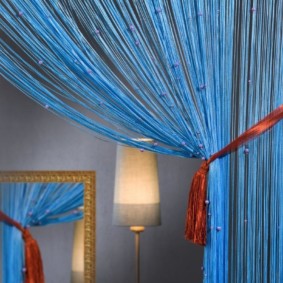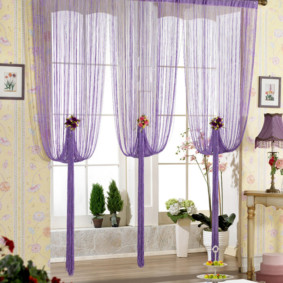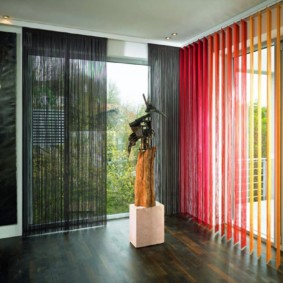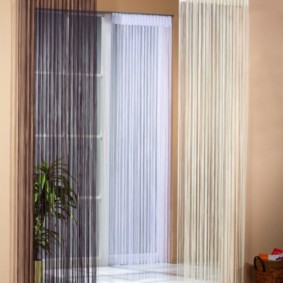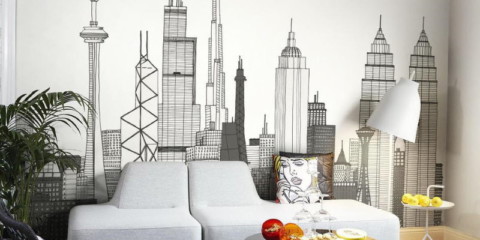 Kitchen
We create with our own hands an attractive interior for the kitchen of 15 square meters. m
Kitchen
We create with our own hands an attractive interior for the kitchen of 15 square meters. m
Kissing curtains are a modern way of window decoration in the kitchen. This design consists of beautiful thin threads that are fixed on a dense fabric. They let in air and visually do not reduce the space even in the smallest room. This type of curtains will be appropriate and relevant for most styles in the interior.

Kissel curtains are most often used in the interior of a kitchen.
A variety of options for the design of muslin in the kitchen can be seen in the photo and choose the appropriate option.

Light, airy threads fit into almost any interior and do not require special care.
Advantages and disadvantages of filament curtains
Content
- Advantages and disadvantages of filament curtains
- Types of Kisei: what they are
- How to decorate the interior of the kitchen with the help of kisei. Options for use in the interior of the kitchen
- Kisei's decorative possibilities: ideas for decoration and drapery
- Filament curtains in various interior styles
- Zoning space using filament curtains
- How to choose color and material
- VIDEO: Filament curtains in the kitchen - design photo.
- 50 design options for curtains for the kitchen:
The advantages of thread curtains in the kitchen.
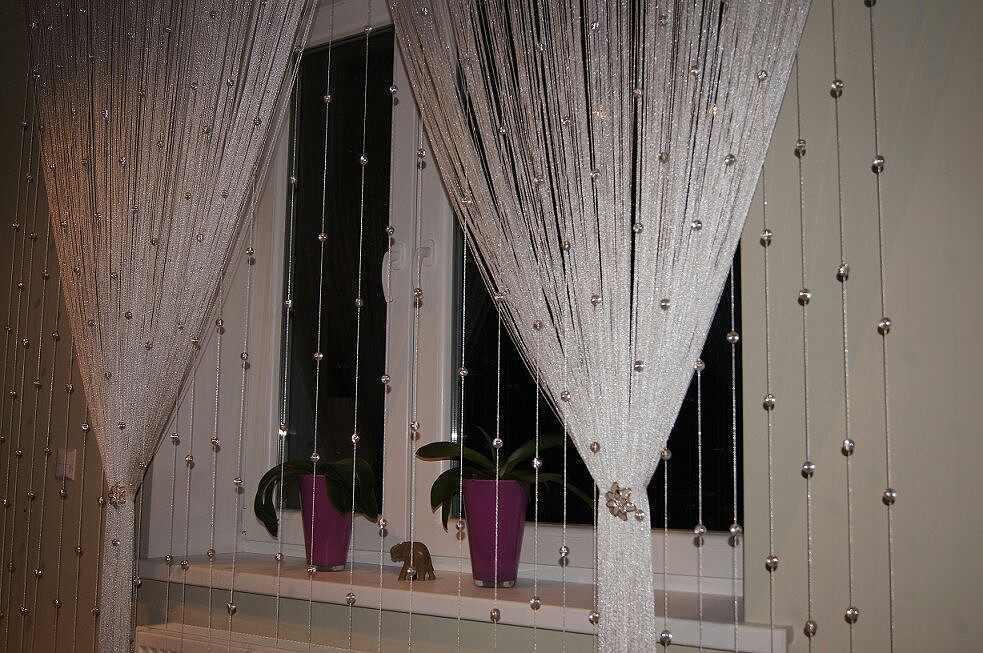
It is precisely because of their practicality that curtains and threads began to be used precisely in the kitchen, where spots of fat, juice, etc. may appear on walls and curtains.
- In order to shorten the filament curtains in the kitchen, it is not necessary to contact the atelier, you can cut them to the desired length yourself. The thread is made of synthetics, which does not open.
- High-quality filament curtains in the kitchen do not need special care. They can be cleaned at home without fear of spoiling.
- Create a soft and natural light in the room.
- Thanks to the special tool used to process the thread curtain, the product does not collect dust and soot. This is very important if such a curtain hangs in the kitchen.
- Does not interfere with air circulation in the room.
- It does not require frequent washing and ironing.
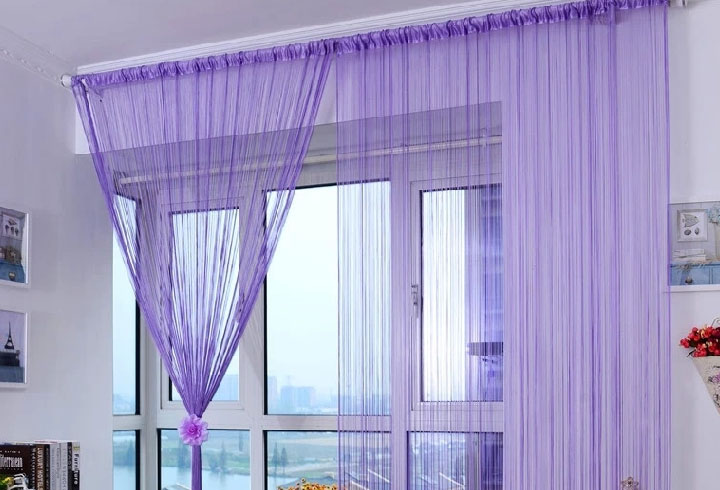
They gained such popularity not only due to their sophisticated look.
The disadvantages of curtains made of threads in the interior of the kitchen.

Kisey curtains are not like ordinary window curtains.
- This type of curtains has the property of being confused, twisting into knots, especially in a draft, but due to the high gliding of the material they are very easy to unravel.
- If the window faces the south side, then the threads may not cope with the shading of the room. In this case, blinds or blinds are installed on the window.

The canvas consists of many thin threads that are held together by a strong strip of fabric.
Important! Do not place muslin curtains close to the stove; they are very flammable.
Types of Kisei: what they are
Filament curtains are distinguished by texture and appearance.

Thread curtains came to us from the East, it was there that long threads were used as light partitions and curtains.
- Synthetics. Universal option for filament curtains. This material always involves a wide selection of color spectrum. They are lightweight and have many design options.
- Lurex. This decorative element can be combined with both natural and synthetic threads. It creates an original play of light and shadow, coziness and comfort.
- Polyester. A practical material that dries quickly after washing. Wearproof and budget option.
- Silk. An expensive and effective version of Kisei. Provide an easy play of light in space.
- Linen. Eco-friendly material. Such curtains are made from plant materials.
- Yarn. This version of the curtains can be created with your own hands or made to order in order to beautifully design the curtains for the kitchen. For this, the necessary yarn and accessories are selected.

Threads gently envelop the window, creating a feeling of comfort and sophistication.
In appearance, kisei are of the following types.

In our country, curtains-threads appeared relatively recently, but quickly gained popularity.
- Narrow threads. Create a fabulous feeling of airiness. Can be used for doorways.
- Wide noodles. Looks like thin ribbons. Relevant for the design of large rooms. It protects from light.
- With the addition of decorative elements. Any muslin in the kitchen can have design options with the addition of a variety of accessories. It can be beads, feathers, beads. Such additional elements are especially relevant as a weighting agent for narrow threads, which are often confused in a draft.
- Spiral-shaped. This form with visual perception gives a sense of harmony. Very practical: after washing they always keep their shape.

Designers fell in love with this material for its wide possibilities for the embodiment of the most daring ideas.
Additional Information! The modern design solution for the southern windows is hanging the muslin in several rows to increase the level of shading.
How to decorate the interior of the kitchen with the help of kisei. Options for use in the interior of the kitchen
There is a large selection of the most diverse options for the interior, among which the most popular are the following.
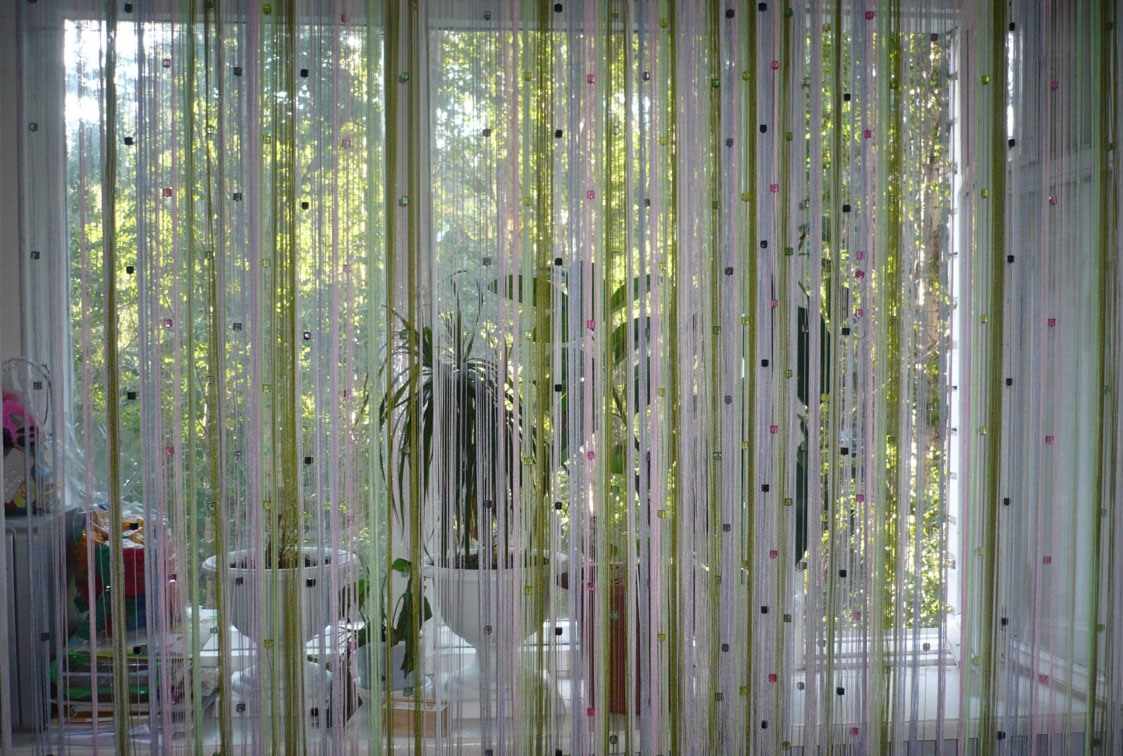
Such curtains can combine two or more colors, be contrasting or with smooth transitions.
- Translucent threads. Look great on panoramic windows. Their weightless appearance makes the room spacious and bright.
- Openwork thread and lurex. An expensive and sophisticated option for a room with an appropriate design. A good idea for a classic interior.
- Short Kiseens A popular solution for modern cuisine.
- Combined Kisei. They look beautiful in combination with additional accessories in the form of beads on panoramic windows.
- Knitted canvas curtains. A good solution for interiors in the style of boho.
- Combination with other materials. Kisei can be combined with blinds, tulles and shutters. Particularly suitable for southern windows where additional protection from sunlight is required.

These curtains refresh the interior.
Interesting to know! The rain effect can be created using thin threads in the floor with lurex. This technique is especially good for tall windows.
Kisei's decorative possibilities: ideas for decoration and drapery
Drapery for filament curtains is created using a variety of accessories: clothespins, grabs, pins, suspensions, magnetic clips, hair clips.

Kisea rain consists of very thin ropes and transparent plastic threads. Due to the weaving of a transparent thread, it seems that there are droplets of water on the curtain.
Fabric pickups. They are sewn to order in tone with the curtains. They are fixed with buttons or adhesive tape.
Magnetic clips. The design of the clip is selected, which will be in harmony with the muslin curtain. The basic rule is the lack of a bulky part on the clip.

Filament curtains are light in themselves, they can not be too heavy.
Hair clips. There is an opportunity to fix a hairpin on any length of a curtain. This technique gives you the opportunity to fly imagination for the designer. Such an opportunity opens the way to the most unusual visual effects.
Suspensions. The combination of tones is important here. The gimbal can become a color accent on the kitten.

For a balcony opening, it is better to choose curtains of light shades, with a transparent or translucent texture, since sunlight penetrates weaker through the balcony.
Filament curtains go well with tulle. This option creates three-dimensionality and depth of space. With it, you can place accents and create a special composition. The basic rules that must be observed when combining filament curtains and tulle.
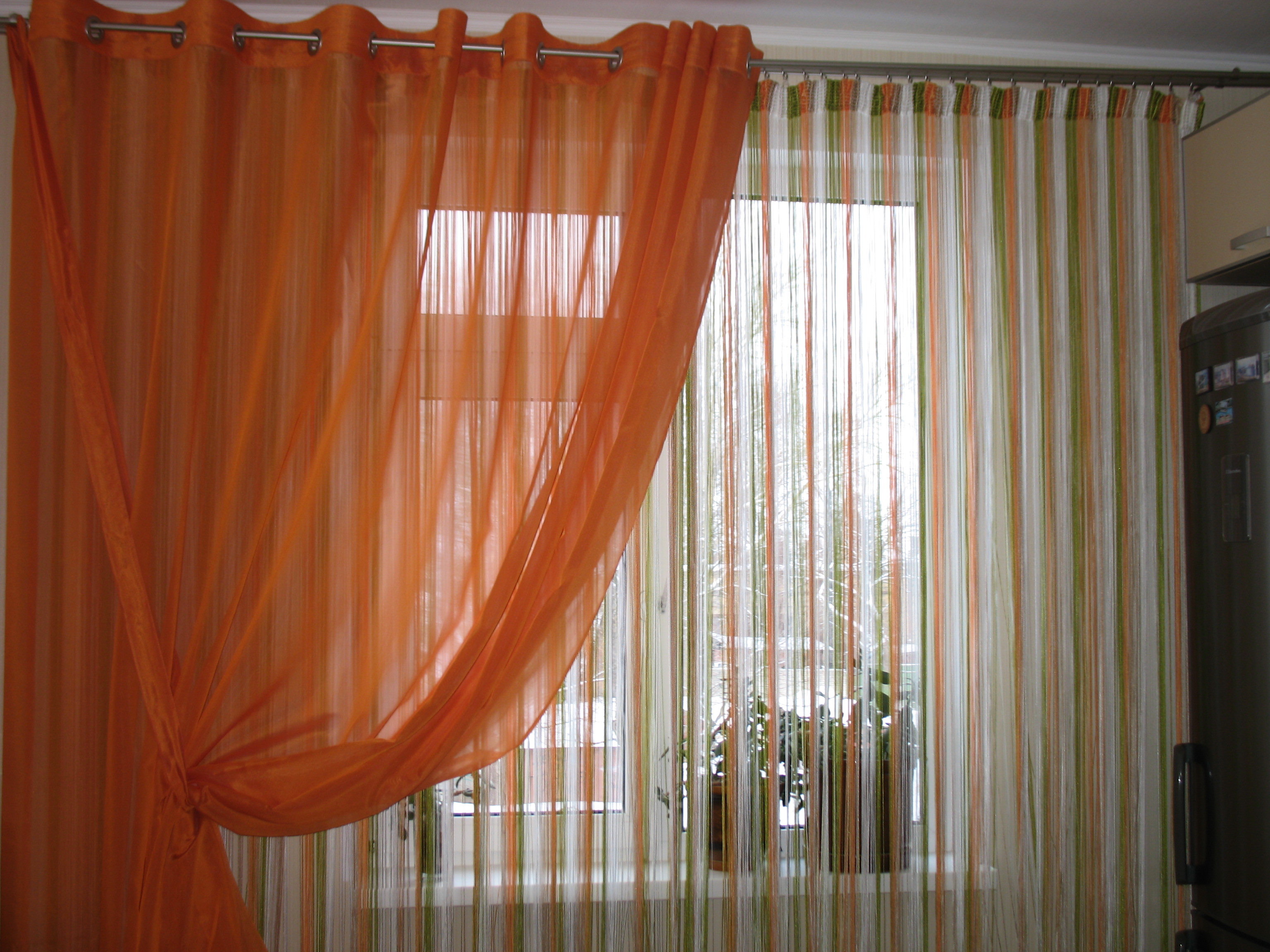
It is better to give preference to a strong, non-shedding fabric, easy to care for.
- Color matching. Colors should be combined among themselves.
- Competent combination of texture. Tulle and muslin should be made of similar material.For example, thin synthetic threads combined with airy organza.

Filament curtains visually increase the space and pass air and sunlight well.
Kiseya in the kitchen - not just for the window. It can often be seen in doorways, very important for rooms with adjacent rooms. Kiseya harmoniously looks in an arch of any shape: oval, square or beveled. To design the doorway, you can use various textures and materials, additional accessories.

To exit to the balcony, you do not need to move the entire curtain - it is convenient to exit through long thin threads even with busy hands.
This design decision to replace the door with muslin curtains will not only create an original composition, but will also save extra money from the cost of buying and installing an interior door.

Kissel curtains are used not only for window decoration, but also for doors.
Attention! Fixation of a muslin curtain in a narrow corridor is best done over the opening. So, there will be an illusion that the space is a little wider than it actually is.
Filament curtains in various interior styles
- Minimalism. For this style, monophonic curtains without lurex are selected, most often in the form of thin threads without additional decorative elements.
- East style. Create an oriental tale will help Lurex. It is this kind of warm-colored kiseya that is characteristic of this style.
- Eco style. Curtains made of linen threads are characteristic. For their production, matte linen of gray, beige shades is used. This is a natural and hypoallergenic material that perfectly conveys the mood of the popular eco-friendly style in the interior.
- Loft. Rain of silver threads with backlight is the best solution for this style in the interior.
- Art Deco. Golden threads with beads and rhinestones, bugles, lurex, feathers.
- Sea style. You can add several assemblies in the form of nodes to the overall composition.
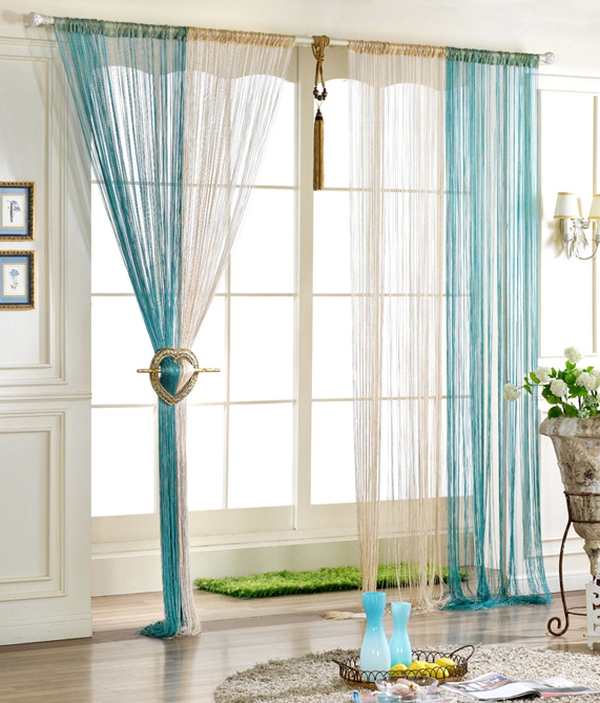
The lighting in the room can be adjusted - for this it is enough to collect or dissolve the threads.
Zoning space using filament curtains
Any room with a large or small area can be divided into zones. Using filament curtains, create a corner for relaxation or a workplace. The main advantage of the muslin partition is that it does not burden the space. With the help of drapery and additional accessories, you can create a wide variety of optical effects.

The length of the curtain is also easily changed - to shorten the curtain, you can tie a bunch or just cut it.
It is possible to isolate a separate part of the room in whole or in part. For a partial partition, it is enough to fence off half of the space.
Zoning is possible at any time. This process does not require global permutations and large material costs. All the basic elements can be assembled independently. Zoning can be done in a frame and hanging way. The most suitable will depend on the functional purpose of the partition.

Kisei curtains are suitable for any design - hi-tech, classic, oriental, minimalism.
The main advantages of zoning the kitchen with a muslin curtain.
- Excellent esthetic appearance and practicality and wear resistance.
- Separation of the dining area from the working.
- Threads for the kitchen are treated with a special tool, thanks to which it does not absorb odors and protects against pollution.
- A large assortment makes it possible to choose the right option for any style in the interior.

Owners of a large kitchen can consider different options for decorating the room.
How to choose color and material
Before deciding on the type and texture of the material of Kisei for the kitchen, you should take into account such points.

The color is selected taking into account the color scheme of the walls and furniture.
- In a small kitchen, muslin curtains in the form of wide noodles will look too bulky, in a space with limited square meters, a thin rope will be relevant.
- For a minimalist style in the interior, give preference to monophonic muskets. The combination of black and white threads is a relevant and suitable solution for a modern discreet interior.
- Light hangers as curtains in the kitchen visually create space in space. Actual for a small kitchen.
- Colored Kisei goes well with glossy kitchen facades. Successful combinations: plum and pink, orange and yellow, blue and lilac, lime and lime, red and pink.
- For the south window in a spacious room, it is better to use wide noodles. This type of curtains will better protect from direct sunlight.

If the windows face north, it is recommended that curtains be chosen in warm colors and vice versa.
Kisei can be used in any interior style without restrictions, this is a sea of additional opportunities for the designer. Absolutely every room for cooking, regardless of size, can be decorated with muslin curtains and additional accessories.
VIDEO: Filament curtains in the kitchen - design photo.
